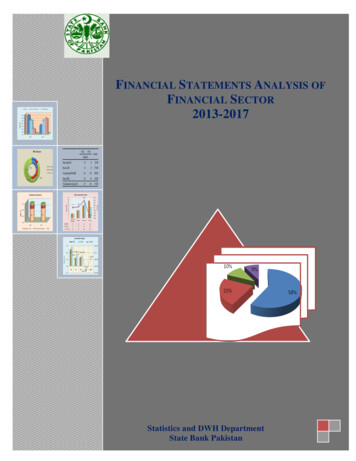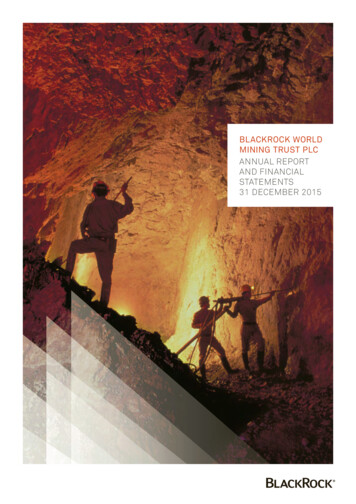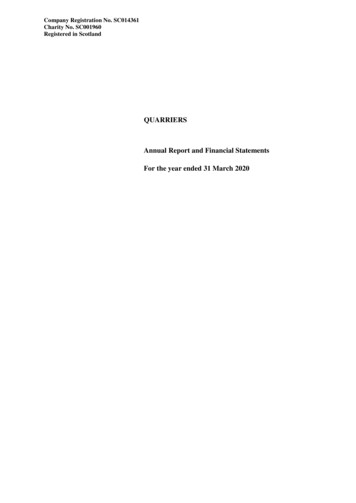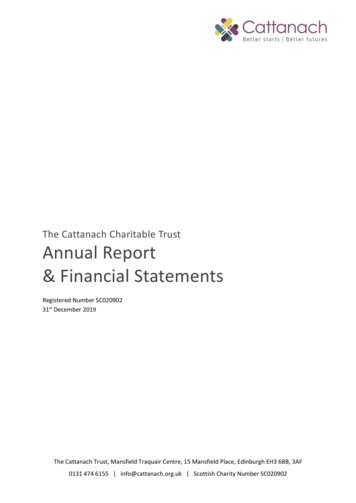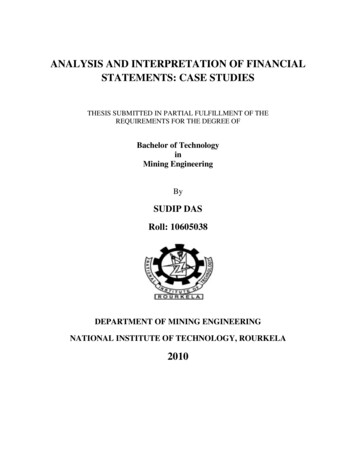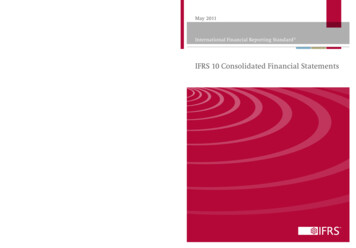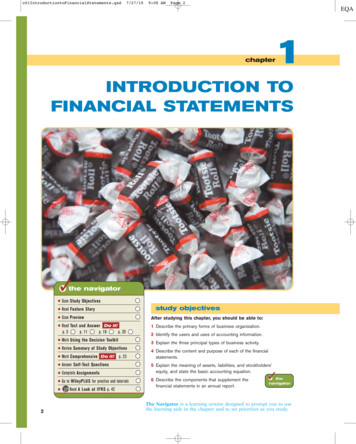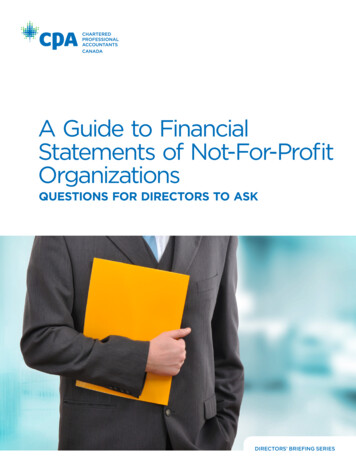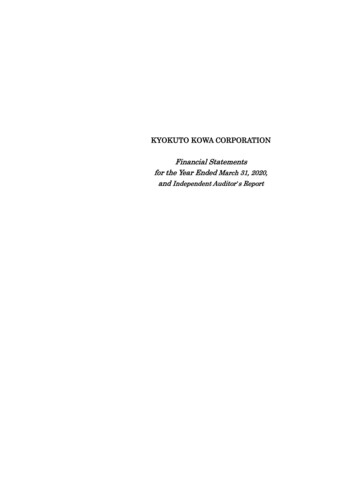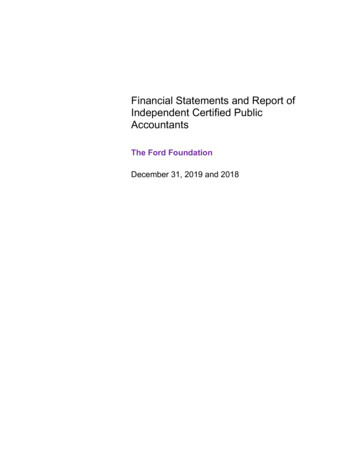
Transcription
Financial Statements and Report ofIndependent Certified PublicAccountantsThe Ford FoundationDecember 31, 2019 and 2018
PageContentsReport of Independent Certified Public Accountants3Financial StatementsStatements of Financial Position5Statements of Activities6Statements of Functional Expenses7Statements of Cash Flows9Notes to Financial Statements10
REPORT OF INDEPENDENT CERTIFIED PUBLIC ACCOUNTANTSGRANT THORNTON LLP757 Third Avenue, 9th FloorNew York, NY 10017D 1 212 599 0100F 1 212 370 4520To the Board of Trustees ofThe Ford Foundation:We have audited the accompanying financial statements of The Ford Foundation (the“Foundation”), which comprise the statement of financial position as of December 31,2019, and the related statements of activities, functional expenses, and cash flows forthe year then ended, and the related notes to the financial statements.Management’s responsibility for the financial statementsManagement is responsible for the preparation and fair presentation of these financialstatements in accordance with accounting principles generally accepted in the UnitedStates of America; this includes the design, implementation, and maintenance ofinternal control relevant to the preparation and fair presentation of financial statementsthat are free from material misstatement, whether due to fraud or error.Auditor’s responsibilityOur responsibility is to express an opinion on these financial statements based on ouraudit. We conducted our audit in accordance with auditing standards generallyaccepted in the United States of America. Those standards require that we plan andperform the audit to obtain reasonable assurance about whether the financialstatements are free from material misstatement.An audit involves performing procedures to obtain audit evidence about the amountsand disclosures in the financial statements. The procedures selected depend on theauditor’s judgment, including the assessment of the risks of material misstatement ofthe financial statements, whether due to fraud or error. In making those riskassessments, the auditor considers internal control relevant to the Foundation’spreparation and fair presentation of the financial statements in order to design auditprocedures that are appropriate in the circumstances, but not for the purpose ofexpressing an opinion on the effectiveness of the Foundation’s internal control.Accordingly, we express no such opinion. An audit also includes evaluating theappropriateness of accounting policies used and the reasonableness of significantaccounting estimates made by management, as well as evaluating the overallpresentation of the financial statements.We believe that the audit evidence we have obtained is sufficient and appropriate toprovide a basis for our audit opinion.
OpinionIn our opinion, the financial statements referred to above present fairly, in all materialrespects, the financial position of The Ford Foundation as of December 31, 2019, andthe changes in its net assets and its cash flows for the year then ended in accordancewith accounting principles generally accepted in the United States of America.Other matterThe financial statements of The Ford Foundation as of and for the year endedDecember 31, 2018 were audited by other auditors. Those auditors expressed anunmodified opinion on those financial statements in their report dated June 13, 2019.New York, New YorkMay 27, 2020
The Ford FoundationSTATEMENTS OF FINANCIAL POSITIONDecember 31,2019(in thousands)ASSETSInvestments, at fair valueRedemption proceeds receivableAccrued interest and dividends receivable 13,617,114112,6724,89613,734,682CashFederal excise tax receivableInvestment related receivablesOther receivables and assets2018 ,10062,4851,7249,6235,947Program-related investments (net of allowancesfor possible losses of 21,139 and 26,892 atDecember 31, 2019 and 2018, respectively)126,186136,765Fixed assets (net of accumulated depreciationof 41,781 and 44,390 at December 31, 2019and 2018, respectively)254,488228,530Total assets 14,230,473 13,053,278 401,935162,32872,75362,795 457,41780,4123,25764,392LIABILITIES AND NET ASSETSUnpaid grantsPayables and other liabilitiesInvestment related payablesFederal deferred excise taxesBond payable, (net of unamortized cost of 1,913 and 1,983 at December 31, 2019 and 2018, respectively)Total encies, commitments and guarantees (Note I)NET ASSETSAppropriatedUnappropriatedTotal net assets without donor restrictionsTotal liabilities and net assets 14,230,473The accompanying notes are an integral part of these financial statements.5 13,053,278
The Ford FoundationSTATEMENTS OF ACTIVITIESYears ended December 31,2019(in thousands)Operating activitiesNet investment return 1,703,197ExpendituresProgram activitiesGrants approvedProvision (recovery) for possible losses onprogram-related investmentsDirect conduct of charitable activitiesProgram managementTotal program activitiesOperational supportDepreciationInterest expenseTotal expendituresChange in net assets from operating activitiesNon-operating activitiesNet periodic pension costs other than service costsPost-retirement changesChange in net assets without donor restrictionsBeginning of period2018 792(2,563)1,485(634,654)12,176,783End of year 13,259,575The accompanying notes are an integral part of these financial statements.625,43912,811,437 12,176,783
The Ford FoundationSTATEMENT OF FUNCTIONAL EXPENSESYear ended December 31, 2019Programmanagementactivities andgrants(in thousands)Grants approved Direct conductof charitableactivities (DCAs)463,369 -2019TotalexpensesOperationalsupport - 463,36941,2152,01229,66572,892Services and professional fees4,72717,1047,83529,666Travel, conferences and meetings2,7103,1239596,792Facility and occupancy2,419-7,1889,607Other operating 61Interest expense3,6711955,7889,65461,139606,788Salaries, wages and benefitsSubtotal 523,004 22,645 Net periodic pension costs2,952other than service costsTotal expenses The accompanying notes are an integral part of this financial statement.7609,740
The Ford FoundationSTATEMENT OF FUNCTIONAL EXPENSESYear ended December 31, 2018Programmanagementactivities andgrants(in thousands)Grants approved Salaries, wages and benefitsDirect conductof charitableactivities (DCAs)515,518 -2018TotalexpensesOperationalsupport - 515,51837,9591,51227,86167,332Services and professional fees7,14814,7308,61930,497Travel, conferences and meetings4,0371,0208855,942Facility and occupancy2,627-9,73812,365Other operating 154481159,61810,11467,143659,015Interest expenseSubtotal 573,984 17,888 Net periodic pension costs2,563other than service costsTotal expenses The accompanying notes are an integral part of this financial statement.8661,578
The Ford FoundationSTATEMENTS OF CASH FLOWSYears ended December 31,2019(in thousands)Cash flows from operating activities:Change in net assetsAdjustments to reconcile change in net assetsto net cash used in operating activities:Realized appreciation on investments, netUnrealized (appreciation) depreciation on investments, netDepreciationPost-retirement changes and net periodic pension costsother than service costProvision (recovery) for possible losseson program-related investmentsDecrease in deferred federal excise tax liabilityIncrease in federal excise tax receivable(Increase) decrease in other receivables and assetsGrant approvalsGrant paymentsIncrease (decrease) in payables and other liabilitiesNet cash used in operating activities Cash flows from investing activities:Proceeds from sale of investmentsPurchase of investmentsChange in redemption proceeds receivableChange in accrued interest and dividends receivableChange in investment related receivablesChange in investment related payablesLoans disbursed for program-related investmentsRepayments of program-related investmentsPurchase of fixed assetsNet cash provided by investing activitiesNet decrease in cashCASHBeginning of periodEnd of period The accompanying notes are an integral part of this financial statement.91,082,7922018 84 62,485
The Ford FoundationNOTES TO FINANCIAL STATEMENTSDecember 31, 2019 and 2018The Ford Foundation (“the Foundation”) is a not-for-profit corporation organized under the laws of the Stateof Michigan, with its headquarters located in New York, New York. The Foundation was established in 1936to make grants in furtherance of scientific, educational and charitable purposes. The Foundation currentlypursues its charitable objectives primarily by making grants intended to reduce inequality in its many forms– economic, political, social and cultural.The Foundation’s goals for more than half a century have been to: Reduce poverty and injustice Strengthen democratic values Promote international cooperation Advance human achievementWhile the specifics of how the Foundation works to advance its goals have evolved over the years,investments in the following three areas have remained the touchstones of everything the Foundation does: Investing in individual leaders Building institutions Supporting new ideasThe Foundation focuses its resources on supporting visionary leaders and organizations working on keysocial justice issues: Civic Engagement and Government; Gender, Ethnic and Racial Justice; Technologyand Society; Natural Resources and Climate Change; Future of Workers; Creativity and Free Enterprise;and Cities and States.NOTE A - SUMMARY OF SIGNIFICANT ACCOUNTING POLICIESThe Foundation’s financial statements are prepared on the accrual basis in conformity with accountingprinciples generally accepted in the United States of America (“GAAP”).The significant accounting policies followed are set forth below:Investments, at Fair ValueThe Foundation makes investments by either directly purchasing various financial positions, or purchasinga portion of an investment fund’s partnership capital or shares representing a net asset value (“NAV”)investment. Directly owned positions are classified for financial reporting purposes as equities, fixedincome or short-term investments. NAV investments in funds are classified for financial reporting as eithercommingled or limited marketability funds.Equity investments are directly held securities, primarily publicly traded. Equities are generally valuedbased upon the final sale price as quoted on the primary exchange or at the bid price if the final sale priceis not quoted. Private equities are valued using market transactions when available. If such transactionsdo not exist, private securities are valued as determined by the Foundation. Fixed income investments aregenerally valued based upon quoted market or bid prices from brokers and dealers, as an approximate offair value. Short-term investments generally include cash and cash equivalents as well as credit or debtsecurities with maturities of less than one year. These credit or debt securities may include U.S.government and agency obligations, repurchase agreements, commercial paper, and similar short-termsecurities. Short-term investments for which market prices are not available are valued at amortized cost,which approximates fair value.Commingled funds are NAV investments in partnerships or investment funds where the Foundation hassignificant transparency into the underlying positions in the funds and that have no significant restrictionson redemption rights. For commingled funds, the NAV is determined by either an exchange or therespective general partners or investment managers. The underlying positions, owned by the commingled10
The Ford FoundationNOTES TO FINANCIAL STATEMENTS - CONTINUEDDecember 31, 2019 and 2018funds, include such investments as exchange-traded and over-the-counter securities. The Foundationgenerally has the ability to redeem capital from commingled funds monthly or more frequently.Limited marketability funds are NAV investments in private equity, venture capital, global equity and hedgefunds, and other private investment entities. For private equity, venture capital, and similar funds, theFoundation generally commits to invest capital upon demand of the general partner or investment manager.For limited marketability funds other than private equity, venture capital, and similar funds, the Foundationgenerally has restricted periodic redemption rights. The Foundation has significant transparency into theunderlying positions of the private equity and venture capital funds although the Foundation cannotgenerally independently assess the value of these underlying positions through a public exchange or overthe-counter market.The Foundation follows the concept of the “practical expedient” under GAAP. The practical expedient isan acceptable method under GAAP to determine the fair value of certain NAV investments that (a) do nothave a readily determinable fair value predicated upon a public market and (b) either have the attributes ofan investment company or prepare their financial statements consistent with the measurement principlesof an investment company as defined by GAAP. As such, NAV investments are presented in theaccompanying financial statements at fair value, as determined by the Foundation. Such fair valuegenerally represents the Foundation’s proportionate share of the net assets of the NAV investment asreported by the underlying investment managers or general partners. Accordingly, the fair value NAVinvestments is generally increased by additional contributions and the Foundation's share of net earningsfrom the NAV investments and decreased by distributions and the Foundation’s share of net losses fromthe NAV investments.The Foundation believes that the carrying amount of its NAV investments is a reasonable estimate of fairvalue as of December 31, 2019 and 2018. Because these investments are not readily marketable, theestimated value is subject to uncertainty, therefore, results may differ from the value that would have beenused had a ready market for these investments existed and such differences could be material.Investment Transactions and Income and ExpensesFor directly owned positions, transactions are recorded on a trade date basis. Realized and unrealizedappreciation (depreciation) on investments is determined by comparison of specific costs of acquisition(identified lot basis) to proceeds at the time of disposal, or market values at the last day of the period,respectively, and includes the effects of currency translation with respect to transactions and holdings offoreign securities. Dividend income is recorded on ex-dividend date and interest income is recorded on anaccrual basis. For unsettled sales or purchases as of the reporting period date, the sales proceeds orpurchase price are recorded as investment related receivables or payables, respectively, and are includedon the statements of financial position.Dividend income, interest income, and realized and unrealized gains or losses on investments are includedin net investment return on the statement of activities which is presented net of external and internalinvestment management expenses, and the provision for federal excise tax.Purchases and sales of securities include “in-kind” distributions from underlying private equity funds for theyears ended December 31, 2019 and 2018 and totaled 335.3 million and 113.6 million, respectively.Realized gains on disposition of distributed securities for the years ended December 31, 2019 and 2018totaled 262.3 million and 80.9 million, respectively.For NAV investments, transactions are recorded on a trade date basis. For unsettled sales or purchasesas of the reporting period date, the sales proceeds or purchase price are recorded as subscription paid inadvance or redemption proceeds receivable, respectively, and are included on the statements of financialposition. Unrealized appreciation (depreciation) is determined by comparison of cost basis to fair value atthe last day of the period. For NAV investments in which the Foundation owns shares or units of an11
The Ford FoundationNOTES TO FINANCIAL STATEMENTS - CONTINUEDDecember 31, 2019 and 2018investment fund, realized appreciation (depreciation) on investments is determined by comparison ofspecific costs of acquisition (identified lot basis) to proceeds at the time of disposal. For NAV investmentsin which the Foundation owns a portion of an investment fund’s partnership capital, realized appreciation(depreciation) is recognized on redemption of partnership interests in excess of cost basis. Realized andunrealized appreciation (depreciation) includes the effects of currency translation with respect totransactions and holdings of foreign currency denominated holdings. The amount of realized andunrealized appreciation (depreciation) associated with these investments is reflected in the statements ofactivities.Fair Value MeasurementsIn accordance with GAAP, the Foundation discloses its assets and liabilities, recorded at fair value into the“fair value hierarchy.” GAAP defines fair value as the price that would be received to sell an asset or paidto transfer a liability in an orderly transaction between market participants at the measurement date. GAAPalso established a fair value hierarchy that prioritizes the inputs to valuation techniques used to measurefair value. The fair value hierarchy gives the highest priority to unadjusted quoted prices in active marketsfor identical assets (Level 1 measurements) and the lowest priority to unobservable inputs (Level 3measurements). The three levels of the fair value hierarchy are as follows:Level 1: Inputs that reflect unadjusted quoted prices in active markets for identical assets or liabilities thatthe Foundation has the ability to access at the measurement date;Level 2: Inputs other than quoted prices which are observable for the asset or liability either directly orindirectly, including inputs in markets that are not considered to be active; andLevel 3: Inputs that are unobservable.Inputs are used in applying the various valuation techniques and refer to the assumptions that marketparticipants use to make valuation decisions. Inputs may include price information, credit data, liquiditystatistics and other factors. A financial instrument’s level within the fair value hierarchy is based on thelowest level of any input that is significant to the fair value measurement. The Foundation considersobservable data to be market data which is readily available and reliable and provided by independentsources. The categorization of a financial instrument within the fair value hierarchy is therefore based uponthe pricing transparency of the instrument and does not necessarily correspond to the Foundation’sperceived risk of that instrument.Investments whose values are based on quoted market prices in active markets are classified as Level 1and generally include cash equivalents and exchange-traded investment instruments. The Foundationdoes not adjust the quoted price for such instruments, even in situations where the Foundation holds alarge position and a sale of all its holdings could reasonably impact the quoted price.Investments that trade in markets that are not considered to be active under the accounting definition, butare valued based on quoted market prices, dealer quot
Dec 31, 2019 · The Ford Foundation NOTES TO FINANCIAL STATEMENTS December 31, 2019 and 2018 . 10 . The Ford Foundation (“the Foundation”) is a not -for-profit corporation organized under the laws of the State of Michigan, with its headquarters located in Ne
